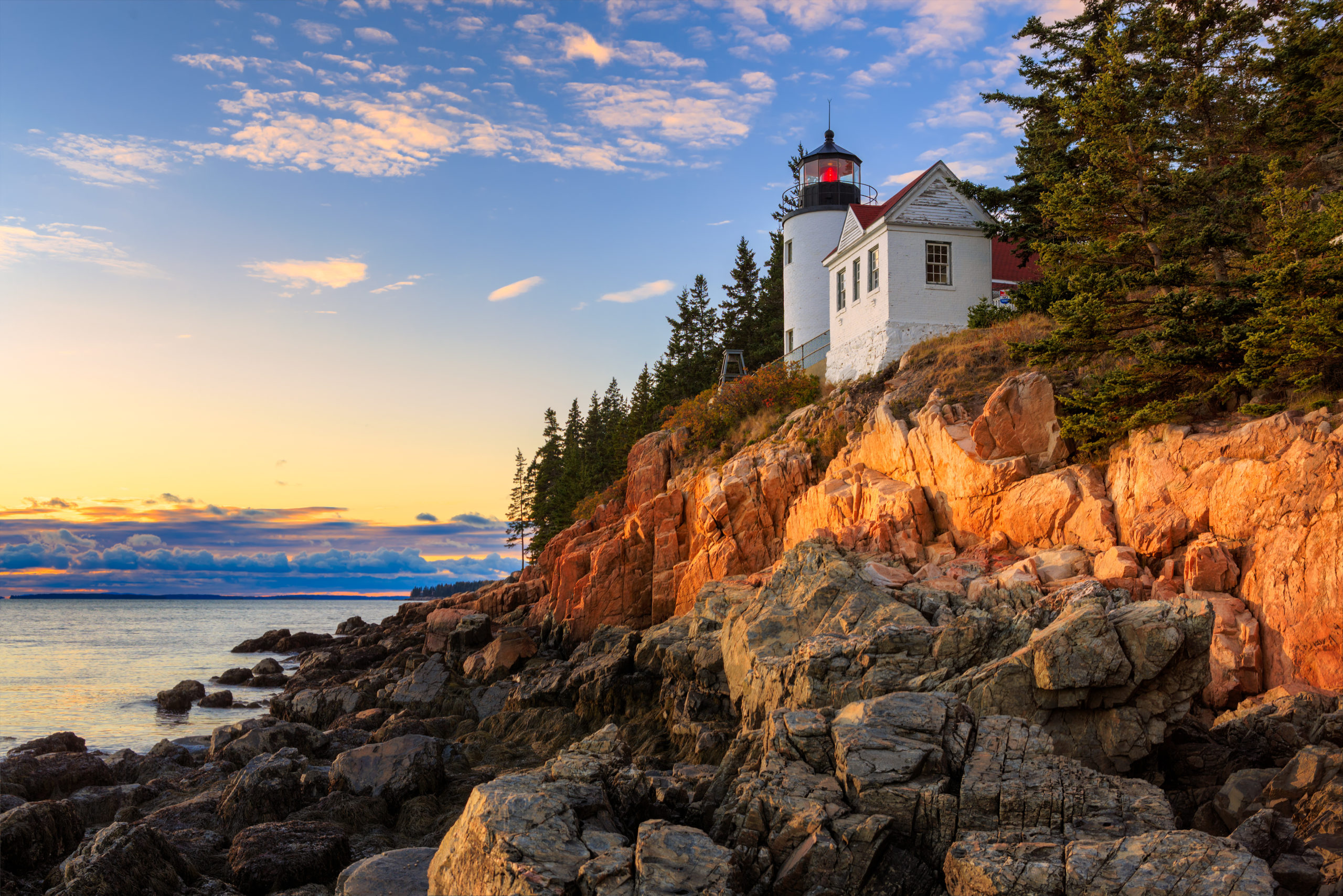The History of Acadia National Park
The first National Park In The Northeast Has a Rich Human history. Here’s Acadia’s story

By KRISTEN BOWIE
Table of Contents
The History of Acadia National Park
Acadia National Park is located on the Central coast of Maine- just southwest of Bar Harbor. The parklands preserve approximately half of Mount Desert Island, part of the Isle au Haut, the tip of the Schoodic Peninsula and parts of 16 smaller islands in the area.
This national park preserves the natural beauty found in the rocky headlands- including some of the highest mountains along the Atlantic coastline. The park’s glaciated and islandic ecosystem welcomes an abundance of habitats and biodiversity, and the history of Acadia National Park boasts a depth that’s steeped in rich cultural heritage.
Acadia National Park: The Human History
Acadia has a rich human history, with stories on this land dating back more than 10,000 years ago and beginning with the Wabanaki people. Native Americans have history with the park that goes back 12,000 years with the Wabanaki Confederacy consisting of five distinct Algonquian nations: The Maliseet, MiKmaq, Passamaquoddy, Abenaki, and Penobscot.

Mount Desert Island remains an active part of the Wabanaki people’s traditional ancestral homeland and is a traditional stewardship responsibility for the tribes people in present day. Some of the nations of the confederacy call Mount Desert Island, “Pemetic,” which means ‘range of mountains.’
In the 17th century, a popular Wakanabi rendezvous site, Castine, was located just west of Mount Desert Island at the mouth of the Bagaduce River and quickly developed into a major fur trading post. The French, English, and Dutch traders all fought for control over the region, where the Wakanabis would trade seal skins, moose hides, and furs for European commodities.
By 1621, warfare combined with introduced diseases like smallpox, cholera, and influenza had decimated the tribes people from Mount Desert Island southward to Cape Cod, only 10% of the original population remained.
After the American Revolution, the United States and Canada established country borders that effectively split the Wakanabi homelands and the confederacy dissolved around 1870 due to political pressure from both countries. This didn’t stop the tribes people- native folks continued to interact in traditional ways and life carried on like it had for centuries.
Modern day Wakanabi Tribes each have their own reservation now, with government headquarters located within each of their territories in Maine.
European Exploration Of Acadia National Park Lands
In 1524, an Italian Explorer by the name of Giovanni da Verrazzano sailed along the coast of Mount Desert Island while on an expedition for the French crown. The following year, Estevao Gomes, a Portugese explorer on an expedition for the Spanish crown, followed in his footsteps.
This continued amongst various expeditions for a number of years. The first meeting between the Wakanabi people and Europeans is unknown, but Frenchman Samuel de Camplain made an important contribution to the historical record of Mount Desert Island.
Leading the expedition that arrived on Mount Desert Island on September 5, 1604, and observed in his journal, “The mountain summits are all bare and rocky…I name it Isles des Monts Deserts.” Champlain’s discovery came a full 16 years before the pilgrims landed at Plymouth Rock, effectively destining this land as New France before it became New England.
“New France”
French Jesuits were warmly welcomed to the Acadia National Park region by the native tribespeople in 1613 as they established the first French mission in America on Mount Desert Island. Work had just begun on building a fort, planting corn, and baptizing natives when an English ship under Captain Samuel Argall’s command destroyed the French mission.
This victorious action by the Englsih doomed the Jesuit efforts on Mounta Desert Island and put the region into a state of limbo- the French firmly entrenched to the North and the British, who were slowly increasing their strength and numbers to the south. Neither country had aspirations to settle in the contested Acadia National Park’s territory. So for the next 150 years, the island’s
Importance was whittled down to being used as a landmark to seamen.
While Mount Desert Island became a navigational tool for ships traversing the coastline, for a moment in time in 1688, it seemed that the island might once again become a center of French activity once again.
That’s because Antoine Laumet – an ambitious young man that had immigrated and dubbed himself as ‘Sieur de la Mothe Cadillac’ and asked for (as well as received) a hundred thousand acres of land along the coast of Maine- including all of Mount Desert Island. Laumet’s vision of establishing a feudal estate on the coastline were shortlived, and Antoine and his wife soon abandoned their efforts. He later gained lasting recognition as the founder of Detroit.
Acadia Becomes Part of New England
After a century and a half of conflict, British troops began to gain ground at Quebec in 1759, effectively ending French dominion in Acadia. By this time, natives in the area had scattered and the Fleur de Lis banished from the land, the coastal lands of Maine opened up for English settlement. The governor of Massachusetts, Francis Bernard, obtained a royal land grant for the lands on Mount Desert Island. Bernard Tried to secure his claim in 1760 by offering free land to settlers. Abraham Somes and James Richards accepted the offer and their families settled in what is now modern-day Somesville.
As the US revolutionary war began, Bernard’s plans for Mount Desert Island soon went up in smoke. The newly minted United States government granted the western half of Mount Desert Island to John Bernard, son of the governor, and the eastern half of the island to Marie Therese de Gregoire, granddaughter of Caddilac. Bernard and de Gregoire soon sold their holdings to non-resident landlords.

shop the collection
The Early Settlements of Acadia
These real estate transactions didn’t actually help increase the number of esttlers that were homesteading on Mount Desert Island, but it made no difference. By 1820, farming and lumbering were in strong contention against fishing and ship building as the leading occupations. Settlers harvestedhundreds of acres of lumber and converted it into a wide range of wood products. Farmers cultivated and harvested wheat, rye, corn, and potatoes.
Near present-day Somesville, the Carroll Family built a home to represent a coastal Maine farm and the hard work of year-round residents of Mount Desert Island in the 1800’s. Generations of the family lived at the Carroll Homestead, which can still be visited today.
By the 1850’s, fishermen and sailors had become commonplace and the presence of fish racks and shipyards had become a way of life linked to the sea.
For a select few Americans, the 1880’s and ‘Gay Nineties’ brought unprecedented affluence. Mount DEsert Island was the perfect remote get-a-way for these Americans and their families. Famously rich Americans like the Rockfellers, Morgans, Fords, Vanderbilts, cArnegies, and Astors built elegant estates. Luxury, refinement, and large gatherings replaced the buckboard rides, picnics, and day hikes of earlier visitors to the area. For over forty years, the wealthy dominated the summer activities on Mount Desert Island, but that all came to a screeching halt during the Great Depression and World War II.
The Birth of Acadia National Park
George B Dorr is known as the “Father of Acadia National Park” and worked with the former president of Harvard, Charles W. Eliot supported the idea of a national park by procuring land donations and advocating both at a state and federal level.
President Woodrow Wilson first established Acadia’s federal status as Sieur de Monts national monument on July 8, 1916 and administered by the National Park Service. Congress redesignated the national monument as Lafayette National Park in 1919. This was significant for a number of reasons- this was the first American national park east of the Mississippi, the only national park in the Northeastern United States, and the first national park created from private lands gifted to the public.
George B Dorr served as the park’s first superintendent. It was originally named Lafayette National Park after the Marquis de Lafayette- an influential French participant in the American Revolution, but was eventually renamed to Acadia National Park in 1929 after the former French colony of Acadia.
Further Development of Acadia National Park
John D. Rockefeller himself oversaw the design, financing, and construction of carriage roads that networked throughout Acadia National Park from 1915-1940. This network of roads originally encompassed about 57 miles of crushed stone carriage roads, 17 stone-faced steel-reinforced concrete bridges, and two gate lodges- one at Jordan Pond and the other near Northeast Harbor.
Rockefeller sponsored landscape architect Beatrix Farrand to design the planting plans along this network of roads. Today, about 45 miles of tehse carriage roads are accessible and maintained within Acadia National Park boundaries.
